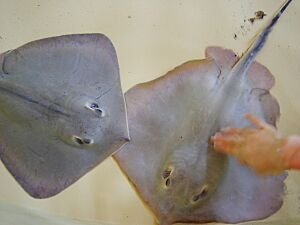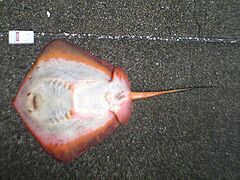Red stingray facts for kids
Quick facts for kids Red stingray |
|
|---|---|
 |
|
| Conservation status | |
| Scientific classification | |
| Genus: |
Hemitrygon
|
| Species: |
akajei
|
| Synonyms | |
The red stingray (Hemitrygon akajei) is a type of stingray. You can find it in the northwestern Pacific Ocean. This includes areas near Japan, Korea, and China. It might live in other places too.
These stingrays usually live in shallow, sandy areas close to the shore. They can even go into brackish water, which is a mix of fresh and salt water. The red stingray gets its name from its bright orange-red belly. It might also have orange spots on its top side. Most of these stingrays grow to be about 1 m (3.3 ft) long.
Red stingrays mostly eat crustaceans like crabs and shrimp, and also small bony fishes. They are important apex predators in their ocean homes. Female red stingrays give birth to live young, usually 1 to 10 pups at a time. People in Japan value the red stingray as food. Many are caught by accident when fishing for other animals. This has caused their numbers to drop. Because of this, the International Union for Conservation of Nature (IUCN) lists them as Near Threatened. This means they could become endangered if their numbers keep falling.
Contents
Where Red Stingrays Live
The red stingray might only live in the northwestern Pacific Ocean. You can find them all along the coast of Japan, from Hokkaidō to Okinawa. They also live near Korea, mainland China, and Taiwan. There have been reports of them in places like Thailand, the Philippines, Fiji, and Tuvalu. However, scientists are still checking if these are truly red stingrays.
These stingrays are often found in sandy areas near the shore. They also live in bays at depths of 10 m (33 ft) or more. You can also spot them in muddy areas, on coral reefs, and in estuaries.
What Red Stingrays Look Like
The red stingray can grow up to 2 m (6.6 ft) long and 0.66 m (2.2 ft) wide. But most are not longer than 1 m (3.3 ft). The heaviest one ever recorded weighed 10.7 kg (24 lb).
They have a body shaped like a diamond, which is wider than it is long. Their front edges are almost straight and meet at a pointy snout. Their small eyes are a bit raised. Behind the eyes are spiracles, which are almost twice as big. These help them breathe.
Inside their mouth, their teeth are arranged like a bumpy pavement. Young stingrays and females have flat teeth. But adult males have sharp, curved teeth. They also have small bumps called papillae on the floor of their mouth.
Their tail is long and thin, like a whip. It is about 1 to 1.5 times longer than their body is wide. A long, jagged spine is located on the first part of the tail. After the spine, there's a small ridge on top and a fold of skin underneath.
Young stingrays have smooth skin. But adults have a patch of small, rough scales called dermal denticles between and behind their eyes. They also have a row of thorns along the middle of their back. There are also some bumps in front of the tail spine.
The top of the red stingray is plain brown. It often has yellow or orange coloring in front of the eyes, behind the spiracles, around the edge of its body, and on the sides of its tail. The tail gets darker, almost black, towards the tip. The underside of the stingray is white with bright orange-red patches.
Red Stingray Life and Diet
The red stingray is an important apex predator in the ocean's food web near the shore. This means it's at the top of the food chain. Their main food is crustaceans, like crabs and shrimp. They also eat small bony fishes and worms. They rarely eat molluscs.
In Tokyo Bay, male red stingrays mostly eat Crangon affinis shrimp. Females prefer Oratosquilla ijimai (a type of mantis shrimp). Young stingrays eat Anisomysis ijimai (a small shrimp). The most common fish they eat is Sardinops melanostictus, also known as the Japanese sardine.
Like other stingrays, the red stingray gives birth to live young. This is called aplacental viviparous reproduction. During mating, the male follows the female and gently bites her body. Females can give birth to just 1 pup or up to 10 pups at a time. Males are ready to reproduce when their body is about 35–40 cm (14–16 in) wide. Females are ready when their body is about 50–55 cm (20–22 in) wide.
Red Stingrays and People
The red stingray has a venomous tail spine. This spine can cause injury to humans if stepped on or handled carelessly. The Ainu, who are native to northern Japan, used to use the dried tail spine as a weapon.
These stingrays are often caught by accident by fishing boats. These boats are usually trying to catch other fish like flounder. They use different types of fishing gear like nets and lines. The red stingray is eaten in Japan, especially around the Tokyo Bay area in autumn and winter. It can be boiled, eaten with miso soup, or made into kamaboko (a type of fish cake).
However, the red stingray is not very big, so it's not a huge part of the fishing industry. The number of red stingrays caught by Japanese fisheries has gone down over the years. In 1950, about 20,000 tons were caught. But from 1997 to 2004, only about 3,959 to 5,388 tons were caught each year. This drop in numbers, along with continued fishing and their slow reproduction rate, has led the International Union for Conservation of Nature (IUCN) to list this species as Near Threatened. This means they are at risk of becoming endangered.




